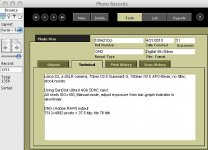DabCan10
Established
I'm looking to catalog my pictures a bit better in Mac os. I currently download my digital pictures into folders marked by the date, then the ones I edit are saved within that folder in another folder marked "edited".
Scanned negs go in a folder named after the camera that was used to take it, again an edited folder is within this one for pictures I do work on.
iPhoto seems like it could handle this although it seems that your files are all put in a photo library and you can't easily find the actual files on your computer without using iPhoto? Perhaps I"m missing something. Also not sure what you would do with scanned photos/negs using iPhoto.
Scanned negs go in a folder named after the camera that was used to take it, again an edited folder is within this one for pictures I do work on.
iPhoto seems like it could handle this although it seems that your files are all put in a photo library and you can't easily find the actual files on your computer without using iPhoto? Perhaps I"m missing something. Also not sure what you would do with scanned photos/negs using iPhoto.


